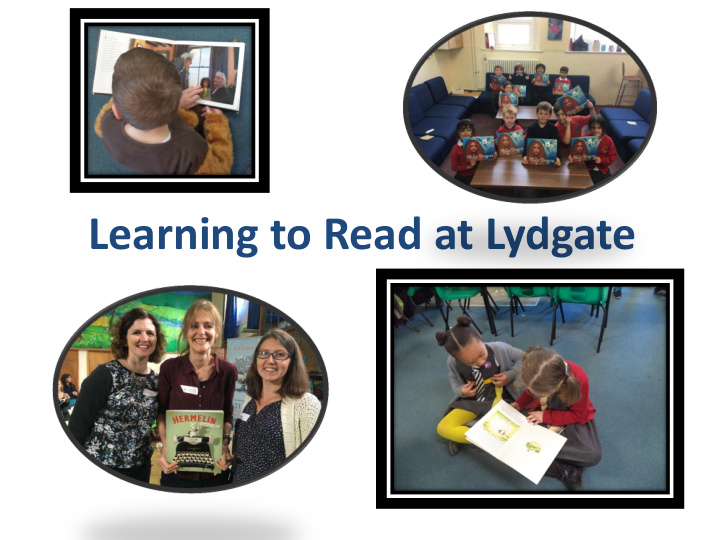



Learning to Read at Lydgate
What is reading? Word- Compre reading hension (skill) (skill) Motivation (experiences)
Phonics • Phonics – how we represent in writing the sounds we say • Same phoneme can be written in lots of different ways c ow ou t j oi n b oy sh e h ee l tr ea t mumm y del e t e p eo ple rec ei ve • Supports reading and spelling
Segmenting and Blending Can you split these words up into their constituent sounds? trip cake mean chair important pumpkin
Segmenting and Blending Can you split these words up into their constituent sounds? trip trip cake cake mean mean chair chair important important pumpkin pumpkin
Phase 2
Phase 3 Tricky Words he all she they we my me be you are was
Phase 4 Tricky words: said were have there like little so one do when some out come what
Phase 5
Decodeable texts Books which are written so children only encounter the graphemes and tricky words they already know. Phonics Bug Not necessary for all children but very useful for some children.
Comprehension Written language is different from spoken language. We need to support children to help them learn to comprehend what they read. Children who enjoy reading and choose to do this regularly do better at GCSE.
‘My child can read all of Roald Dahl’ o Do they understand it? o How do you know? o Aim for the end of Y2 is to read Gold/White fluently and with good understanding. o Lime = Y3; Brown = Y4
Reading to children and talking about the books we read will build their understanding of the sentence structures and vocabulary we are more likely to come across in reading.
Fluency • Read aloud fluently, showing understanding of what they read. – Accurate word-reading – Pausing at punctuation (and recognising what the punctuation tells us) – Good expression (which matches the mood of the text)
Literal and inferential comprehension The boy wandered through the wood munching on his green, juicy apple. What is the boy eating? – Literal retrieval question How does the boy feel? How do you know? – inferential understanding
‘Activating Background Knowledge’ Jane was invited to Jack’s birthday party. She wondered if he would like a kite. She went to her room and shook her piggy bank. It made no sound. What do you already know which helps you understand this?
Four skills children need to practise • Summarizing The child has a chance to say what has happened so far, giving a short synopsis of what they’ve just read in that paragraph or on that page. • Questioning This involves the child asking questions which help them to self-check their understanding of what they are reading. Skilled readers check their own understanding regularly as they read. As expert readers, we can ask the children questions which help them to delve beneath their literal understanding of the text. • Clarifying Here the reader has the opportunity to ask for clarification about the meaning of unknown words or phrases. It’s a good idea to take time to discuss unusual vocabulary or phrases with children as they read. • Predicting This involves the children using the evidence they have so far – from the text and pictures – to say what they think might happen next. They may make links with other stories – films or books – when making their predictions and this is great!
Booktalk
Motivation • Reading to our children motivates them to persevere themselves • Texts they enjoy (including re-reading texts) • Permission – book corners at school and bookboxes/shelves at home • At age 15: PISA shows strong associations between reading enjoyment and performance … the finding is consistent with research showing that enjoying reading is an important precondition for becoming an effective reader . Therefore, to bolster reading performance, schools need to both instruct students in reading techniques and foster an interest in reading.
How we teach reading at school • Phonics (Letters and Sounds) • Guided Reading • Storytime • English lessons • 1:1 reading • Whole Class reading • Library visits • Home/School Reading diary
Book Bands • Goldilocks Principle – not too easy, not too hard, just right • Children need to understand what they are reading, not just read the words really quickly • We assess the children to decide when they need to move on • Talk to your child’s teacher about your child’s progress – they may agree or you may have a useful discussion about your child’s current gaps. • End of Y2: Gold/White
How you can support your child at home • 3 – 5 times a week • Supportive reading experiences: not a test (take it in turns; talk; games; time-limits etc) • Get your child to apply their phonics • Activating background knowledge: Tell them names of characters/places; identify sounds they’re going to meet; make links with own experiences • DO pay attention to your child’s understanding • DO communicate with us – this is a partnership • DON’T struggle alone, we’re here to support you
Reading is… … a gift every child has a right to … a door onto a world of experiences and information beyond the child’s own experience … not always easy – but we can get every child there
Recommend
More recommend